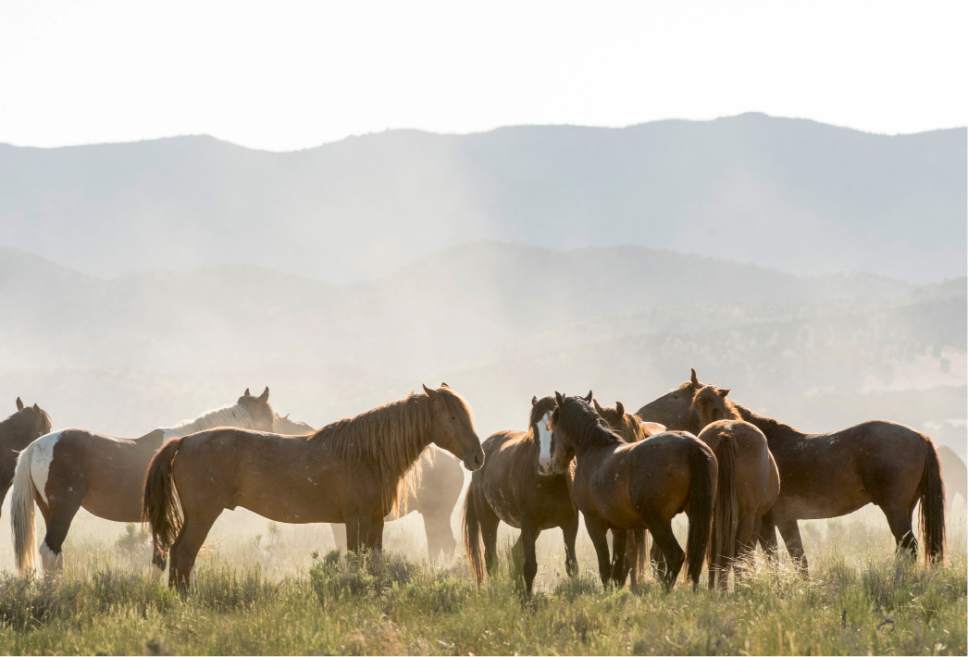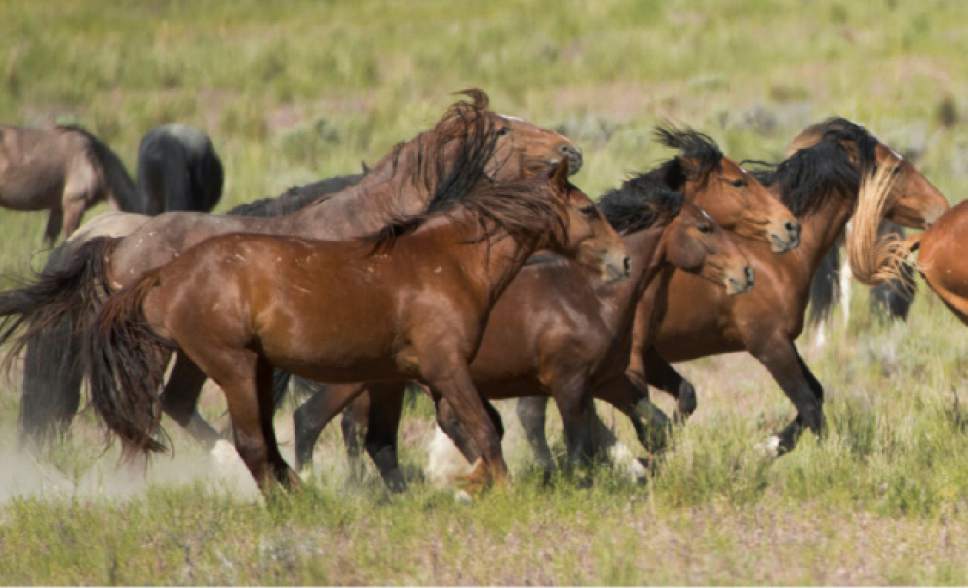This is an archived article that was published on sltrib.com in 2017, and information in the article may be outdated. It is provided only for personal research purposes and may not be reprinted.
Federal management of wild horses has been a dismal failure, resulting in ecological and economic havoc on Utah's public ranges, according to new legislation that seeks repeal of the 1971 statute protecting free-roaming horses and burros.
Two bills and an appropriation request promote state management that envisions sharply reducing horse numbers through slaughter and permanent sterilization — measures sure to draw stiff opposition from horse advocates.
But Utah lawmakers and county commissioners are fed up with the Bureau of Land Management's approach, which they say allows horses to proliferate at the expense of range health, livestock operators and native wildlife while wasting $50 million a year confining horses that could be slaughtered for their meat.
"The fragmentation coming out of D.C. is tremendous," Rep. Ken Ivory, R-West Jordan, told the House Natural Resources, Agriculture and Environmental Quality Committee on Wednesday. "This is a hell for the ecosystem, it's is a hell for the wildlife species, it's is a hell for those on the ground who are told the solution is to cut back their livelihoods and their herds. It's a hell for the animals themselves; they are starving and dying. Clearly we can do this better." Ivory is the sponsor of HCR22, a resolution calling on the federal government to either take immediate steps to "humanely preserve the feral horse and burro populations in the West at established population management objectives" or cede that authority to the state.
Horse advocates reject the premise of this measure, which is one component of a package of legislative actions targeting wild horse management.
Rep. Keven Stratton, R-Orem, is seeking $1.1 million to manage Utah's 19 herds, whose population now exceeds 5,000, or about 2½ times the BLM's target. He is also sponsoring a bill that lays out a state management plan. Stratton and others have made it clear state management could entail slaughtering horses, but horse advocates say such proposals would face a buzz saw of controversy.
"Utah is a beautiful state. I would hate to see it get a black eye with these crazy inhumane plans," said filmmaker Ginger Kathrens, executive director of the Cloud Foundation and member of the BLM's wild horse advisory board. "You would have to have the law changed where Utah is this special place where they get management and their plan is to kill them. That's jumping through an awfully narrow hoop. It irks me that they are so blind to the benefits [of free-roaming horses] and can't see beyond their ignorance. They are so out of step with what the American public wants. When you talk about killing healthy animals and trafficking them to Mexico, it's just disgusting."
But lethal population control is in line with positions advocated by Interior Secretary nominee Ryan Zinke as well as the BLM advisory panel, which urged the agency last September to offer "all suitable animals in long- and short-term holding deemed unadoptable for sale without limitation or humane euthanasia. Those animals deemed unsuitable for sale should then be destroyed in the most humane manner possible." Advisory panel members said they were not endorsing slaughter for meat, but after a negative public reaction, the BLM pledged it would not destroy healthy horses and burros.
Ironically, Utah's new legislative push comes as the BLM conducts its most aggressive roundups in Utah in years. Last month, 700 horses from the Sulphur herd were gathered in Beaver County and the agency is currently rounding up the Cedar Mountain herd west of Tooele. So far, 534 horses have been gathered with a goal of 600 to 700. In both these gathers, the BLM planned to administer a fertility vaccine to 200 mares and return them to the range with an equal number of stallions. That decision prompted a lawsuit from Beaver County, alleging the BLM should not return horses to the Sulphur herd area, where horse numbers still exceed the "appropriate management level."
The Utah operations deploy birth control known as PZP-22, which activates the immune system to thwart conception. This drug is effective for a year or two, and Utah lawmakers want to see something longer lasting. In addition to lethal measures, Ivory's resolution calls for scaled-up use of GnRH-based vaccines, a new fertility-control technology that "can permanently sterilize a young horse by inhibiting the hormones that would make it sexually mature."
Most horse-advocacy groups endorse PZP, but that is not the case with GnRH, or GonaCon, which they say has not been proven safe.
"GonaCon interferes with the animals' reproductive hormones and could negatively impact natural behaviors. It is important to preserve these natural behaviors since that is what distinguishes wild horses from their domestic counterparts," said Suzanne Roy, executive director of the American Wild Horse Preservation Campaign.
Killing healthy horses will raise far bigger objections. The practice is allowed under the 1971 Wild Free-roaming Horses and Burros Act, but current federal regulations will not permit Department of Agriculture inspectors to sign off on horse meat. Utah lawmakers want to change that so meat from Utah horses can be sold.
"There is a need for the animal protein worldwide but because we don't allow a federal inspector to inspect packing houses we have not been able to utilize the resources we have," Sen. David Hinkins, R-Orangeville, said at a Feb. 9 appropriations committee meeting. Kathrens noted there are no U.S. slaughterhouses that handle horses, so animals marked for slaughter would have to be exported. The last time a buyer shipped wild horses to Mexico, more than five years ago, the public outcry was intense and the Interior Department put a stop to it.
Utah lawmakers said the state Division of Wildlife Resources has developed a detailed horse management plan, but DWR Director Greg Sheehan said the plan has yet to be fleshed out since there are so many unknowns about how much authority Utah could get. He said long-term warehousing of horses is not an option.
"That could cost millions of dollars. Our state is not interested in doing that," Sheehan said. He suspects that destroying horses could be the humane thing to do if it prevents herds from starving.
"We don't do that with dogs and cats," Sheehan said. "We prosecute people who allow their horses to get like that."
County commissioners complain that, under BLM management, horses are suffering on ranges that have become depleted due to overpopulation.
"We have completely decimated the springs. You can't fence off the springs, the horses have trampled them.... Horses are grazing 24 hours a day, 365 days a year. They go where they want. There is no management whatsoever unless they keep the numbers down. It's obvious BLM is not able to manage them," Beaver County Commissioner Tammy Pearson told lawmakers earlier this month. "We need to take the emotion out of this. Our wildlife is suffering. Our livestock are suffering. Our natural resources are suffering. In our desert climate, there is no coming back on this. Our springs are drying up. It's like ground zero."
Horse advocates say it's ridiculous to blame horses for range conditions when cattle outnumber horses by as much as 9-to-1 on the West's public ranges. They agree corralling horses for life is too costly and ineffective, but they would rather see the BLM do more on-the-range management, principally through administering PZP with dart guns, obviating the need for roundups.
Wild horses occupy about 2 million acres in Utah, or about 10 percent of the BLM land open to livestock grazing.
"It seems like wild horses have become a lightning rod for the ranchers' dissatisfaction with the federal government," Roy said, "but the reality is that wild horses occupy a tiny fraction of federal lands grazed by livestock."
Brian Maffly covers public lands for The Salt Lake Tribune. Brian Maffly can be reached at bmaffly@sltrib.com or 801-257-8713.
Twitter: @brianmaffly





